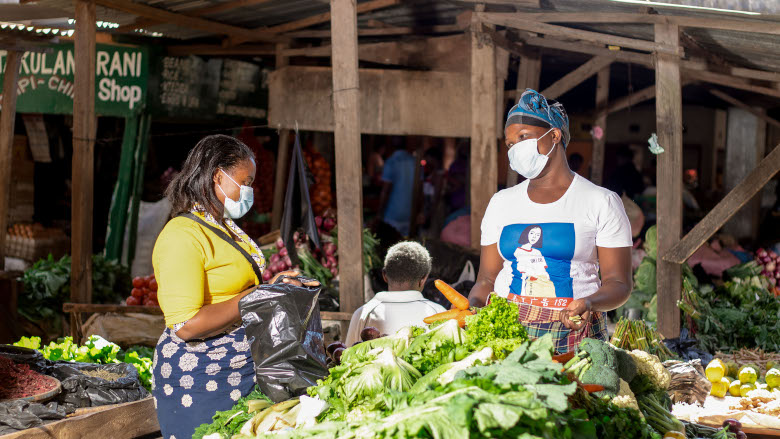LILONGWE, July 24, 2020 – Before the first case of COVID-19 was announced in Malawi, hair salon owner Ebony Phiri would tend to an average of 20 clients a day in the City of Blantyre, bringing home about $180.
Then the government announced the lockdown to stem the spread of the coronavirus, and business slowed. At the end of a 10 hour day, Phiri had only tended to three customers.
Three weeks after the first COVID-19 case, Priscilla Valentini, director of Golden Opportunity Services employment agency, was grappling with a chaotic situation created by clients who, due to salary cuts and job losses, had failed to pay salaries for their domestic and security workers. There were also more than 100 people loitered on the premises looking for security jobs or domestic or hospitality work. Before the pandemic, she would find jobs for nearly 100 people monthly, but the numbers have significantly reduced by one-third, despite the government’s early suspension of the 21-day lockdown.
Impact of COVID-19
The Malawi Economic Monitor (MEM), From Crisis Response to a Strong Recovery, explains that while the widespread economic impact of the COVID-19 crisis will be felt in the fourth quarter and beyond, the negative trends have already been observed in many small-scale businesses and businessowners, such as Phiri and Valentini.
“When Government announced the lockdown in April, enforcing social distance measures and closing borders, my business significantly shrunk because at that time we had run out of products such as hair creams, hair extensions and other make up products that we normally use in the salon,” said Phiri.
Valentini observed that the demand for domestic workers has reduced because most people are now working from home and schools remain closed. Therefore, families can manage daily household affairs with support from relations and their children. The need for an extra hand is no longer there.
“This situation is even worse for domestic workers who used to commute from their homes to work because the threat of COVID-19 is now high,” she said. “About 90% of the households I used to serve are no longer interested to bring in someone who on a daily basis uses public transport and their movements after work cannot be tracked.”
Government’s Response to COVID-19
The MEM further notes that while the lockdown never went into effect, the government’s initial steps to address the health and economic impact of the epidemic such as expansion of social protection, fiscal and monetary measures, as well as steps to support the financial sector and the expansion of mobile money services, have significantly lessened the impact.
In addition, the establishment of an Emergency Liquidity Assistance framework to support banks in the event of worsening liquidity conditions, a moratorium on interest and principal payment for microfinance institutions, facilitating mobile money and e-payments, and establishing a liquidity fund for small-medium enterprises, are likely going to mitigate the impact.
“Despite the serious challenges the pandemic poses for Malawi’s economy, there is a pathway towards recovery,” said Hugh Riddell, World Bank Country Manager for Malawi. “However, finding that pathway will depend on important policy and reform choices and a key priority will be to achieve a critical balance between the need to respond to the crisis, protecting lives and livelihoods while also signaling clear commitment to prudent fiscal management.”
While the pandemic continues to spread and more cases are reported in Malawi, the MEM provides three overriding policy actions:
- Protecting lives, which requires containing the spread of the disease through smart containment measures and putting in place the measures needed for the prevention, detection, and treatment of the disease
- Protecting livelihoods by ensuring that essential trade continues where food markets and trade continue. Farmers should continue to have access to critical inputs and support businesses particularly those in the informal sector like that of Ebony and Priscilla so that they are able to provide salaries for their workers and eventually access liquidity support
- Protecting the future which should necessarily go towards promoting a broad-based economic recovery by addressing the immediate crisis and making investment in some sectors that may face long lasting shocks including the tourism industry to create the foundations for a solid recovery
Economic Outlook
In monitoring the economy, the MEM notes that Malawi’s economy grew by 4.4 percent in 2019, a marked increase from 3.5 percent in 2018 supported by a rebound in agriculture production, as maize and key crops apart from tobacco increased.
Real gross domestic product (GDP) growth for 2020 was projected in September 2019 at 4.8% due to an expectation of the second consecutive year of strong harvests, offset by continuing political uncertainty weighing on business activity and investment. Growth prospects are highly uncertain as the pandemic continues to unfold, but the MEM projects growth at 2.0 percent in 2020, although there are considerable downside risks.
Repeated high fiscal deficits have contributed to an accumulation of domestic debt so that Malawi’s stock of public debt remained level at 59.4 percent of GDP between 2018 and 2019, due to a decline in the stock of external debt, from 31.2 to 29.7 percent of GDP, while domestic debt increased from 28.2 to 29.7 percent of GDP.
